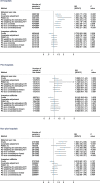The trends and associated adverse maternal and perinatal outcomes of labour neuraxial analgesia among vaginal deliveries in China between 2012 and 2019: a real-world observational evidence
- PMID: 33736635
- PMCID: PMC7977606
- DOI: 10.1186/s12916-021-01941-6
The trends and associated adverse maternal and perinatal outcomes of labour neuraxial analgesia among vaginal deliveries in China between 2012 and 2019: a real-world observational evidence
Abstract
Background: There is a lack of national report of the labour neuraxial analgesia (NA) rates in China in recent years, especially after the national promotion policy. The adverse maternal and perinatal outcomes associated with NA in China are also unknown. The aim of this study is to estimate the trends of NA rates from 2012 to 2019, to evaluate the effect of national policy on promoting NA and to identify the association between NA and adverse outcomes in China.
Methods: We used the individual data from China's National Maternal Near Miss Surveillance System (NMNMSS) between 2012 and 2019, covering 438 hospitals from 326 urban districts or rural counties in 30 provinces across China. The analysis was restricted to singleton pregnant women who underwent vaginal delivery at or after 28 completed weeks of gestation. We estimate the trends of NA rates between 2012 and 2019, both at the national and provincial levels using Bayesian multilevel model. We also estimated the effect of the national pilot policy launched in 2018 using interrupted time-series analysis and identified the association between NA and adverse outcomes using modified Poisson regression combined with propensity score analysis.
Results: Over the study period, 620,851 of 6,023,046 women underwent vaginal delivery with NA. The estimated national NA rates increased from 8.4% in 2012 to 16.7% in 2019. Most provinces experienced the same rapid rise during this period. The national pilot policy accelerated the rise of the rates. No differences were observed between women with NA and without any analgesia in the incidence of uterine atony, placental retention, intrapartum stillbirths and 1- and 5-min Apgar scores lower than 7. However, women with NA had higher incidences of genital tract trauma (adjusted relative risk (aRR) 1.53, 95% confidence interval (CI) 1.04-2.26) and maternal near miss (aRR 1.35, 95% CI 1.08-1.69), only in hospitals which were not covered by the national pilot policy and usually lack of sufficient equipment and personnel.
Conclusions: The national policy can effectively increase the NA rate. However, as genital tract trauma and maternal near miss may increase in low-resource hospitals, but not in high-resource hospitals, further study is required to identify the reasons.
Keywords: Bayesian multilevel model; China; Interrupted time-series analysis; Intervention; Labour neuraxial analgesia; Maternal near miss; Propensity score.
Conflict of interest statement
The authors have declared that no competing interests exist.
Figures



Similar articles
-
Labor Neuraxial Analgesia and Its Association With Perinatal Outcomes in China in 2015-2016: A Propensity Score-Matched Analysis.Anesth Analg. 2023 Nov 1;137(5):1047-1055. doi: 10.1213/ANE.0000000000006435. Epub 2023 Mar 7. Anesth Analg. 2023. PMID: 37862597
-
Prior caesarean section and likelihood of vaginal birth, 2012-2016, China.Bull World Health Organ. 2018 Aug 1;96(8):548-557. doi: 10.2471/BLT.17.206433. Epub 2018 Jul 16. Bull World Health Organ. 2018. PMID: 30104795 Free PMC article.
-
Relaxation of the one child policy and trends in caesarean section rates and birth outcomes in China between 2012 and 2016: observational study of nearly seven million health facility births.BMJ. 2018 Mar 5;360:k817. doi: 10.1136/bmj.k817. BMJ. 2018. PMID: 29506980 Free PMC article.
-
The incidence, risk factors and maternal and foetal outcomes of uterine rupture during different birth policy periods: an observational study in China.BMC Pregnancy Childbirth. 2021 May 5;21(1):360. doi: 10.1186/s12884-021-03811-8. BMC Pregnancy Childbirth. 2021. PMID: 33952183 Free PMC article.
-
Initial Preference for Labor Without Neuraxial Analgesia and Actual Use: Results from a National Survey in France.Anesth Analg. 2015 Sep;121(3):759-766. doi: 10.1213/ANE.0000000000000832. Anesth Analg. 2015. PMID: 26086620
Cited by
-
Interrupted-time-series analysis of the immediate impact of COVID-19 mitigation measures on preterm birth in China.Nat Commun. 2022 Sep 3;13(1):5190. doi: 10.1038/s41467-022-32814-y. Nat Commun. 2022. PMID: 36057724 Free PMC article.
-
Epidural labor analgesia is a potential risk factor for increased blood loss within two hours after delivery in women with gestational hypertension: a retrospective cohort study.BMC Pregnancy Childbirth. 2025 May 6;25(1):538. doi: 10.1186/s12884-025-07648-3. BMC Pregnancy Childbirth. 2025. PMID: 40329279 Free PMC article.
-
Procedural analgesic interventions in China: a national survey of 2198 hospitals.BMC Anesthesiol. 2022 Aug 6;22(1):250. doi: 10.1186/s12871-022-01783-6. BMC Anesthesiol. 2022. PMID: 35933333 Free PMC article.
-
Childbirth in Bhutan: A study on the use of neuraxial analgesia for labor pain.Public Health Chall. 2023 Mar 7;2(1):e73. doi: 10.1002/puh2.73. eCollection 2023 Mar. Public Health Chall. 2023. PMID: 40496958 Free PMC article.
References
-
- Qu Y. Necessity of promoting for labor analgesia technology and the challenges facing. Int J Anesth Resu. 2008;29(6):574–577.
-
- National Health Commission of the People’s Republic of China . Opinions on strengthening and improving Anaesthesia Medical Service [in Chinese] 2018.
Publication types
MeSH terms
LinkOut - more resources
Full Text Sources
Other Literature Sources

